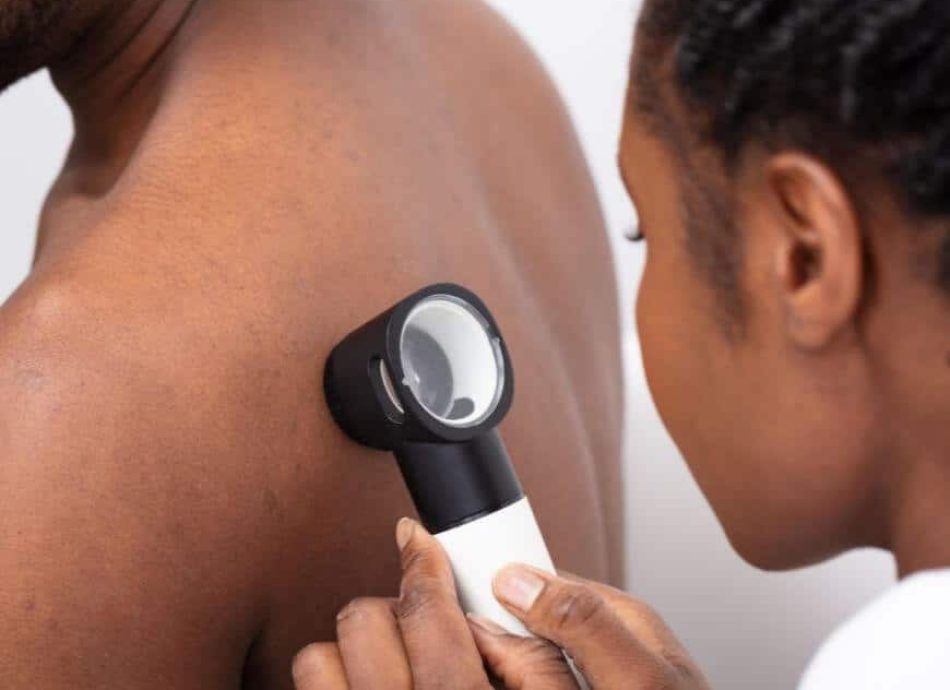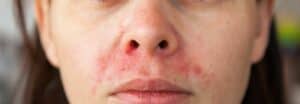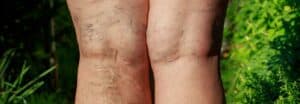Award winning dermatology service, with over 20 years of experience
Short waiting lists, on some occasions offering same week appointments
Safe environment, in Care Quality Commission approved facilities
PHOTODYNAMIC THERAPY IN SHREWSBURY, SHROPSHIRE
Photodynamic therapy is a popular skin cancer treatment used to remove superficial precancerous lesions such as Actinic Keratoses, Bowen’s Disease and Basal Cell Carcinomas. This treatment is effective in treating non-melanoma skin cancer, which are a group of cancers which slowly develop in the upper layers of the skin. They are the most common forms of skin cancer, with over 400 people in the UK being diagnosed with the condition every day. If caught early enough, skin cancer can be treated and cured.
Photodynamic therapy works by using light and a cream. A light sensitive, topical cream is applied to the affected area. A light source, either natural or artificial, is then directed at the skin which reacts with the cream and destroys the abnormal cells. Both the cream and the light are harmless on their own, but when the cream is exposed to light, a reaction is caused. The skin around the lesion is protected with suncream so as to not be damaged by exposure to light.
You may experience mild tingling in the treated area but this can be soothed by a water spay. Following treatment, it is important to avoid direct sunlight for 48 hours as you will be more sensitive to light.
If you suspect you have skin cancer, or would like to find out about any of our skin cancer treatments, please get in touch to arrange a consultation with one of our Doctors.
USING PHOTODYNAMIC THERAPY TO TREAT SKIN CANCERS
Photodynamic Therapy successfully treats Non-melanoma skin cancers these include (BCC) Basal cell carcinoma and (SCC) Squamous cell carcinoma in situ or Bowen’s disease. BCC affects cells in the basal layer of the epidermis.
PDT is a highly effective treatment for treating some pre-cancerous skin lesions such as actinic keratosis and Bowen’s disease. These lesions are skin irregularities which have a risk of developing into cancer. Using the localised Photodynamic Therapy, we first apply a photosensitising agent to trigger a chemical reaction in the skin using red light.
BOWEN’S DISEASE
Bowen’s disease is a common slow-growing pre-cancerous skin lesion, it can be mistaken for psoriasis or eczema. Often, it’s a red scaly patch on the skin. Left untreated these lesions can develop into Squamous cell Carcinomas (SCC).
ACTINIC KERATOSIS (AK)
An AK is the term used for a precancerous lesion of the skin arising as a consequence of overexposure to sunlight, resulting in the skin cells growing at an abnormally fast rate. AKs are usually found on the face, tips of ears, backs of hands, forearms and lower legs, and are reddish-brown in colour with a rough rather warty surface.
BASAL CELL CARCINOMA (BCC)
BCCs (also known as rodent ulcers) are a type of skin cancer that either takes the form of a single bump or a series of small bumps. Multiple lesions are sometimes found in the same patient. This type of skin cancer rarely spreads to other parts of the body, however, early treatment is recommended because, if ignored, the tumour can enlarge and become locally invasive.
ACTINIC CHEILITIS
Actinic Cheilitis is a lesion that develops on the lip it looks like chapped lips and can become scaly and white. Although it’s not painful, there is a risk it can develop into SCC. A lesion can go away by itself but can reoccur and it is common to see more than one lesion at the same time. Lesions sizes and colour vary. There are a range of treatments offered and treatment using PhotoDynamic therapy is effective to eradicate these lesions.
PHOTODYNAMIC THERAPY CAN ALSO BE USED FOR:
FACIAL REJUVENATION
Since the development of PhotoDynamic Therapy for facial rejuvenation has developed from the treatments of skin lesions. This treatment uses specific chemical-based products which activate in the skin using light to boost the production of new skin cells. As a result, it creates a more youthful appearance of the skin. Treatment is effective in treating sun-damaged skin helping to remove pigmented lesions and improve the condition and elasticity of the skin.
ACNE TREATMENT
PhotoDynamic Therapy is becoming a much more widely accepted treatment for forms of Acne. Results have shown to be highly effective for patients where other treatments have not been successful. This non-invasive treatment helps the condition by shrinking and destroying the oil glands that produce oil. PDT can also kill the bacteria responsible for causing the spots. When PhotoDynamic Therapy is the treatment of choice for acne, we may combine this with other treatments for maximum results and we will discuss this during your consultation if needed.
FREQUENTLY ASKED QUESTIONS
HOW DOES PHOTODYNAMIC TREATMENT WORK?
INDIVIDUAL LESIONS
We will first prepare the lesion by removing the built-up skin cells, removing crusts and accumulated debris. Cream is then applied to the lesions and the area next to it, and a dressing which you must remove or disturb. This stays in place for 3 hours. After 3 hours, we will remove the dressing, position the light and apply this for around 8-10 minutes. During this, we will provide goggles to protect the eyes.
LARGE AREAS, REJUVENATION OR ACNE
To prepare the skin, we will first clean the skin, and then we will remove any built up excess skin cells to allow the products to penetrate the skin. Next, we apply a special gel to the treatment area which is then covered with a dressing. This should stay in place for 3 hours allowing the products to penetrate into the skin. It is important to protect the skin from direct sunlight and cold during this time. Once the skin has absorbed the gel, we will remove the dressing will and you will lay down with your eyes protected whilst we apply the light. The amount of time will depend on the intensity of the light delivered as the treatment requires a specific dose. Following treatment, we will remove the gel, and apply sunscreen for protection. After PhotoDynamic therapy, you will generally require at least two follow up sessions spaced 1 week apart.
Aftercare advice:
• Keep the treatment area clean and dry for 24 hours
• Use the skincare recommended for you at the consultation.
• Take paracetamol can for any pain.
• Protect the treated area from the sun for 2 days
• Use a protective sunscreen as advised by your dermatologist
WHAT IS THE DIFFERENCE BETWEEN PHOTODYNAMIC THERAPY AND DAYLIGHT PHOTODYNAMIC THERAPY?
The only difference between these two treatments is the light source that is used. In Photodynamic Therapy, an artificial light in the form of a lamp or a laser is used. In Daylight Photodynamic Therapy, the light source is natural daylight.
DO I NEED TO PREPARE FOR PHOTODYNAMIC THERAPY?
It is recommended that you cover up on your way home from the treatment to avoid sunlight as much as possible. If the treatment is on your face, it is a good idea to bring a hat, scarf or sunglasses. If the treatment is on your body, wear clothes which will cover any exposed skin.
REQUEST A CALL BACK
Please fill in this form and one of our team will give you a call back to arrange a consultation with one of our expert dermatologists.

HEAR FROM OUR PATIENTS
WHY HAVE PHOTODYNAMIC THERAPY AT ST. MICHAEL'S CLINIC?
Here at St. Michael’s Clinic, Shrewsbury’s leading private skin and laser treatment clinic, our experts are specialists in all aspects of dermatology, skin cancer, anti-ageing and beauty treatments. We are able to offer NHS patients consultant-led dermatology services in Shrewsbury.
St. Michael’s Clinic is regulated by the Care Quality Commission, ensuring the best level of treatment is provided to you in a safe environment. We are part of the Dermatology Partnership, a leading group of dermatology clinics, defined by clinical excellence and focusing on leading dermatological care.
INSIGHTS AND ADVICE

Your Guide to Autumn Skincare
With the weather gradually cooling and leaves taking on their autumnal palette, it’s also a gentle reminder that winter is on its way. Maintaining a vibrant and healthy skin during the transition from summer to cooler days can be challenging. Fear not – this comprehensive

The Definitive Guide to Eczema
Eczema Awareness Month in October is a global initiative spotlighting those who suffer from this demanding skin ailment. Our perpetual aim is to arm you with a well-rounded understanding of eczema‘s core causes, differing treatments and beneficial coping mechanisms. This all-inclusive guide offers penetrating insights

Exploring Varicose Veins: Recognising, Managing and Preventing
Varicose Disease Awareness Month is focused on raising awareness about varicose veins, a common but frequently overlooked condition affecting millions globally. Throughout September, our goal is to emphasise the importance of early detection, explore the causes, treatment options and highlight lifestyle changes that can help




